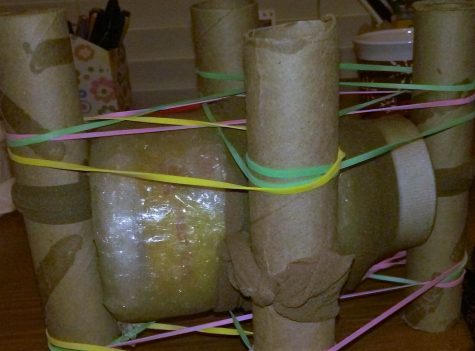Physics Made Fun
Students retrieve their contraptions after dropping them from the rotunda, in hopes the egg inside is intact.
January 14, 2017
The annual egg drop project, held earlier this week, is a tradition for Centennial physics classes, featuring raw eggs placed in strange contraptions hurled off the top of the rotunda while students hold their breaths in hopes that their egg—and grade—will be spared. Adding to the fun, alarmed passersbyers might just take a bath in the process—an egg wash, that is.
Physics teacher Kimberly Garduño says this is a project both she and her students look forward to every year.
“Many students ask me when we’re going to do the egg drop at the beginning of the school year, “ Garduño said. “When we actually do it, it’s an exciting day.”
Students, such as junior Carly Beatty, enjoy this project because it provides an opportunity to socialize while brainstorming the best way to go about making the device.
“My favorite part about this project was hanging out with my friends and my older siblings, thinking about ways to not crack the egg and talking about how other people did it in other classes,” Beatty said.
The project’s purpose was to create a light, yet sturdy contraption that would be capable of delivering students’ delicate cargo (the egg) from a fall of 5.2 meters from the top of the rotunda without letting it crack, a challenge for many including Beatty.
“The hardest part of the project was finding some kind of material that was easy to make the device out of that wouldn’t break the egg, and making the device light,” Beatty said.
Much to the dismay of students, more eggs crack than stay intact, something Garduño says is due to varying amounts of time and effort that is put into this project.
“Even though a lot of the students do research and some build very similar projects, some eggs crack and some don’t,” Garduño said. “Some kids put in more time and a little more thought to it, and some try to replicate it but don’t put in as much time. I also think that creativity and complexity being worth more points than the egg actually staying intact has to do with it as well.”

One student’s project.
And students certainly deliver on the creativity. Garduño says the most creative project she’s seen in all the years she’s taught featured a suspended egg.
“I saw a project that they suspended the egg in the middle of the box but it was the way they suspended it was interesting,” Garduño said. “Normally students would do a small box inside a big box and then use rubber bands, but this person put skewers and two layers of fabric through the box, with the egg sitting in the middle of those two layers of fabric. So it had the same effect but it was kind of an ingenious way of doing it.”
The egg drop is meant to teach students about how impulse and momentum affect how much force something experiences in a collision, and can easily be applied to the real world, according to Garduño.
“The main way we look at applying this to the outside world is with car crashes,” Garduño said. “When you’re looking for your first car, you need to consider if mass and size are on your side, and how that car protects you if you’re in a crash by decreasing force through increasing the amount of time that that force acts on you.”
Beatty says she learned a lot about physics while doing this project.
“The egg drop definitely helped me understand physics better, especially what we’re learning about right now, momentum, impulse and velocity,” Beatty said.
The egg drop project, beneficial to learning and allowing a little bit of fun, is legendary in Centennial, thanks to the students who enjoy it so much.
“This project is probably my favorite after all the projects I’ve done,” Beatty said. “I know future students who take physics will enjoy it greatly.”



